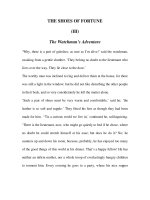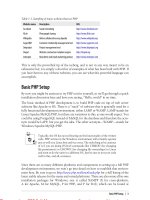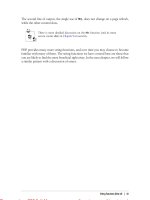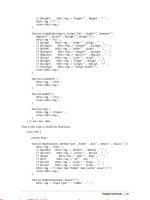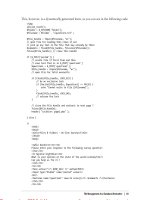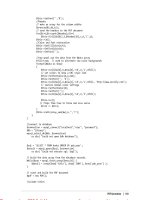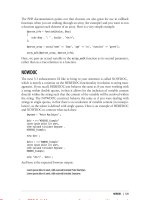The best of wilmott II
Bạn đang xem bản rút gọn của tài liệu. Xem và tải ngay bản đầy đủ của tài liệu tại đây (4.82 MB, 407 trang )
The Best of Wilmott
Volume 2
Edited by
Paul Wilmott
The Best of Wilmott
Volume 2
The Best of Wilmott
Volume 2
Edited by
Paul Wilmott
Copyright Wilmott Magazine Ltd
Published in 2006
John Wiley & Sons Ltd, The Atrium, Southern Gate, Chichester,
West Sussex PO19 8SQ, England
Telephone (+44) 1243 779777
Email (for orders and customer service enquiries):
Visit our Home Page on www.wiley.com
All Rights Reserved. No part of this publication may be reproduced, stored in a retrieval system or transmitted in any
form or by any means, electronic, mechanical, photocopying, recording, scanning or otherwise, except under the terms of
the Copyright, Designs and Patents Act 1988 or under the terms of a licence issued by the Copyright Licensing Agency
Ltd, 90 Tottenham Court Road, London W1T 4LP, UK, without the permission in writing of the Publisher. Requests to
the Publisher should be addressed to the Permissions Department, John Wiley & Sons Ltd, The Atrium, Southern Gate,
Chichester, West Sussex PO19 8SQ, England, or emailed to , or faxed to (+44) 1243 770620.
Designations used by companies to distinguish their products are often claimed as trademarks. All brand names and
product names used in this book are trade names, service marks, trademarks or registered trademarks of their respective
owners. The Publisher is not associated with any product or vendor mentioned in this book.
This publication is designed to provide accurate and authoritative information in regard to the subject matter covered. It
is sold on the understanding that the Publisher is not engaged in rendering professional services. If professional advice
or other expert assistance is required, the services of a competent professional should be sought.
Other Wiley Editorial Offices
John Wiley & Sons Inc., 111 River Street, Hoboken, NJ 07030, USA
Jossey-Bass, 989 Market Street, San Francisco, CA 94103-1741, USA
Wiley-VCH Verlag GmbH, Boschstr. 12, D-69469 Weinheim, Germany
John Wiley & Sons Australia Ltd, 42 McDougall Street, Milton, Queensland 4064, Australia
John Wiley & Sons (Asia) Pte Ltd, 2 Clementi Loop #02-01, Jin Xing Distripark, Singapore 129809
John Wiley & Sons Canada Ltd, 22 Worcester Road, Etobicoke, Ontario, Canada M9W 1L1
Wiley also publishes its books in a variety of electronic formats. Some content that appears
in print may not be available in electronic books.
Library of Congress Cataloging-in-Publication Data
The best of Wilmott 2 / edited by Paul Wilmott.
p. cm.
Includes bibliographical references and index.
ISBN-13 978-0-470-01738-8 (cloth : alk. paper)
ISBN-10 0-470-01738-4 (cloth : alk. paper)
1. Derivative securities. 2. Finance—Mathematical models. 3. Risk management.
4. Options (Finance) I. Title: Best of Wilmott two. II. Wilmott, Paul.
HG6024.A3B517 2005
2005020005
332.64 5—dc22
British Library Cataloguing in Publication Data
A catalogue record for this book is available from the British Library
ISBN-13 978-0-470-01738-8 (cloth : alk. paper)
ISBN-10 0-470-01738-4 (cloth : alk. paper)
Typeset in 10/12pt Times by Laserwords Private Limited, Chennai, India
Printed and bound in Great Britain by Antony Rowe Ltd, Chippenham, Wiltshire
This book is printed on acid-free paper responsibly manufactured from sustainable forestry
in which at least two trees are planted for each one used for paper production.
Contents
Preface
ix
Foreword
Elie Ayache
xi
Chapter 1 Time’s Up
Dan Tudball
1
Chapter 2 First Cause
Dan Tudball
11
Chapter 3 The Collector: Know Your Weapon—Part 1
Espen Gaarder Haug
23
Chapter 4 The Collector: Know Your Weapon—Part 2
Espen Gaarder Haug
43
Chapter 5 Take a Chance
Bill Ziemba
59
Chapter 6 Good and Bad Properties of the Kelly Criterion
Bill Ziemba
65
Chapter 7 Algorithms: Mathematics of Gambling and Investment. The Stochastic
Programming Approach to Managing Hedge and Pension Fund Risk,
Disasters and their Prevention
Bill Ziemba
73
Chapter 8 Efficient Estimates for Valuing American Options
Mike Staunton
91
Chapter 9 The Relative Valuation of an Equity Price Index
Ruben D. Cohen
99
vi
CONTENTS
Chapter 10 What the Spreadsheet Said to the Database, Just Before the Regulator
Shut Down the Trading Floor. . .
Brian Sentance
133
Chapter 11 Emotionomics: Ask Marilyn and Win a Car
Henriette Prast
137
Chapter 12 Risk: The Ugly History
Aaron Brown
141
Chapter 13 Finformatics: Thirst for Hurst
Kent Osband
147
Chapter 14 TARNs: Models, Valuation, Risk Sensitivities
Vladimir V. Piterbarg
153
Chapter 15 Fast Valuation of a Portfolio of Barrier Options under the Merton’s
Jump Diffusion Hypothesis
Antony Penaud
Chapter 16 An Analysis of Pricing Methods for Basket Options
Martin Krekel, Johan de Kock, Ralf Korn and Tin-Kwai Man
Chapter 17 Pricing CMS Spread Options and Digital CMS Spread Options with
Smile
Mourad Berrahoui
173
181
197
Chapter 18 The Case for Time Homogeneity
Philippe Henrotte
211
Chapter 19 Hybrid Stochastic Volatility Calibration
Domingo Tavella, Alexander Giese and Didier Vermeiren
221
Chapter 20 Can Anyone Solve the Smile Problem?
Elie Ayache, Philippe Henrotte, Sonia Nassar and Xuewen Wang
229
Chapter 21 Philosophy of Finance: Definitive Smile Model: Part I
Elie Ayache
265
Chapter 22 Philosophy of Finance: Definitive Smile Model: Part II
Elie Ayache
273
CONTENTS
vii
Chapter 23 A Perfect Calibration! Now What?
Wim Schoutens, Erwin Simons and Jurgen Tistaert
281
Chapter 24 Timing the Smile
Jean-Pierre Fouque, George Papanicolaou, Ronnie Sircar and Knut Sølna
305
Chapter 25 Inference and Stochastic Volatility
Alireza Javaheri
317
Chapter 26 A Critique of the Crank Nicolson Scheme Strengths and Weaknesses
for Financial Instrument Pricing
Daniel J. Duffy
333
Chapter 27 Finite Elements and Streamline Diffusion for the Pricing of Structured
Financial Instruments
Andreas Binder and Andrea Schatz
351
Chapter 28 No Fear of Jumps
Y. d’Halluin, D. M. Pooley and P. A. Forsyth
Index
365
379
Preface
The team at Wilmott is very proud to present this compilation of magazine articles and presentations from our second year. We have selected some of the very best in cutting-edge research,
and the most illuminating of our regular columns. Our columnist, the Collector, contributes his
infamous ‘Know Your Weapon’ series in which he espouses the principle that it is more important
to have a robust model that you understand than a fancy one you don’t. Dr Z gets down to basic
concepts of money management, and Aaron gives us a history lesson.
The technical papers include state-of-the-art pricing tools and models. You’ll notice there’s
a bias towards volatility modelling in the book. Of course, it’s one of my favourite topics, but
volatility is also the big unknown as far as pricing and hedging are concerned. We present research
in this area from some of the best newcomers in this field. You’ll see ideas that make a mockery
of ‘received wisdom’, ideas that are truly paradigm shattering – for we aren’t content with a
mere ‘shift’. Several of these articles are from that hive of original thought that is ITO33. Elie
Ayache has also written his own introduction to this compilation. And, in true French philosopher
tradition, he’s been at the absinthe again!
Finally a big ‘thank you’ to all supporters, the subscribers and the sponsors!
Paul Wilmott
2005
Foreword
Elie Ayache
And so it fell to me to write an introduction for Best of Wilmott 2. To quote from the introduction
of Best of Wilmott 1, by Paul Wilmott: ‘In September 2002 a small, keen group. . . joined forces
with a book publisher to create a new magazine, Wilmott. . .’
‘In September 2002 ’, ‘Create’, ‘New ’: These words speak of birth and novelty; they set a
‘source point’. Somehow Paul’s attempt at introducing Best of Wilmott 1 is easier than mine
today. His introduction is self-giving and originary, whereas mine is a sequel. Mine is unoriginal
and derivative. Also, the title of the first book speaks for itself: ‘This is the first edition of the best
of Wilmott.’ What better way to present a subject than the conjunction of these two superlatives?
‘To write’, ‘Introduction’: Mark these words as I will revisit them later and remark on them.
To give you a hint: This is a book about derivatives and derivatives are essentially all about
writing —they are said to be written on the underlying. How then do you introduce the derivatives
or write about them? By first introducing their underlying? And how do you introduce that?
By floating it? (The French word for ‘floating’ is ‘introduire en bourse’.) What better way of
introducing the derivatives than joining their market at once? Shouldn’t we all stop writing and
start trading? And how can you introduce a market, or introduce somebody to trading?
Why me?
The name of Paul Wilmott imposes itself as best introducer of Best of Wilmott. I have been
considering a variant of the title with the name of Wilmott crossed out. In private correspondence
Paul Wilmott indeed refers to the book simply as Best of 2. Call it selflessness, or self-evidence.
Simply, the man could not get over speaking both in his name and for his name. Imagine him
asking me: ‘Could you please write me an introduction for Best of me, volume 2 ?’
‘Best of 2 ’: The formula almost strikes me like a derivative payoff. And this suits my purpose
just fine. As it severs the link with the original name of the initial introducer, this elliptical formula
seems, as a consequence, to dispense with personality and proper name altogether. Writing is
impersonal. Just as anybody can write a derivative payoff, anybody can write an introduction for
Best of 2. The market is impersonal. Writing derivatives is just a way of handing back to the market,
i.e. to impersonality, the skewed and exotic and idiosyncratic scenarios that the market may have
Contact address: ITO33 SA, 36 rue Lac´ep`ede, 75005 Paris, France
E-mail:
xii
FOREWORD
inspired you personally. Writing is derivative. It always comes after speech. A compilation book
always comes after the articles compiled in the book, and the introduction of the compilation book
always comes after the compilation book, never before—have you noticed? (Not mentioning that
volume 2 always comes after volume 1.)
Let us pursue the thread of the derivative for a while, that is to say, of impersonality and unoriginality, and let us forget about the best and the privilege of writing about the Best. Essentially,
what I inherit today is the endless task of rewriting. Since a compilation book is a repackaging
and a rewriting of articles initially published in the magazine, writing an introduction for the
compilation book is writing about the rewriting of articles initially written about the derivatives
which are all about writing. How can I even start to do that? Did the writing of derivatives start
one day or has it always been going on? Did the writing of articles about the derivatives start one
day? Did the market start one day? Or has the writing always been going on? From my personal
and localized point of view, something has definitely always preceded my writing. This is volume
2, remember?
Having thus dissolved the superlative and the privilege of introducing it in the impersonal
chain of writing, I may as well move, without further notice or introduction, to what interests
me personally. I am not Paul Wilmott after all, the editor-in-chief and impartial arbitrator of
Wilmott, so the reader will have to excuse a little extremism on my part. And what interests me,
what interests me in general and in the particular instance (which is, as expected, an instance of
writing and rewriting and writing about writing), what has always interested me to the exclusion
of anything else, is replication. (Imitation?)
When you neutralize the primary meaning of the best of (the value judgement) and retain only
the derivative meaning (of a compilation and a rewriting), all you end up with is a replication
argument. Buy this book, so the argument goes, invest in it an initial fee, and you will have
replicated a process of writing, editing and publishing that has lasted for a whole year. From
which it appears that the process of selection of the ‘best’ articles—whose other side is the
rejection of others—is just the necessary consequence of idealization. It has nothing to do with
good or bad, with best or worst, only with relevant and significant. It is a modelling assumption
like any other, with its expected share of choice and sacrifice. Mustn’t you specify a robust
dynamic model before you try to replicate a given payoff?
All of which brings me to volatility. And to writing an introduction for the second issue of
Best of Wilmott, where there is contained, as you will see, a lot of volatility papers. How do
you introduce volatility? Isn’t it, by essence, the subject that has always already started and has
always already been introduced? A lot has been written on volatility (otherwise, I wouldn’t be
today in the position of writing an introduction for a compilation of papers written about volatility).
However, what interests me in volatility today—as you must have guessed by now—is to write
about it derivatively. Not only because I am in the business of writing about the writing of
volatility papers, but because volatility, as an original and underived concept, is now disappearing
everywhere. ‘Writing about volatility derivatively’—for those who didn’t catch my drift—just
means ‘writing about volatility by way of the derivative’. What else? Where is volatility to be
observed in the world, apart from the traded prices of derivative instruments?
I might as well say it straight, at the risk of shocking the reader and shaking him (but this,
according to Paul Wilmott in the introduction of Best of 1, is exactly what I am supposed to
do): There is no meaning to volatility outside the derivative and nobody today knows how to
price the derivative! ‘A lot has been written on volatility’ therefore can only mean ‘A lot of
derivatives have been written’, and it is only through this writing, which is constantly submitted
FOREWORD
xiii
to the impersonal rewriting of the market, that volatility can mean anything at all and ever get
introduced. Volatility as the (unobservable) measure of risk, volatility as historical volatility, does
not in the least interest us. And certainly no book—let alone the introduction to a book—can
teach us its meaning. Volatility can only be meaningful within the language of volatility, which
is the language of derivative prices. It can only be meaningful within the fabric of the derivative
market, that is to say, the market as both a texture and a text.
So volatility can only mean something in the derivative sense of volatility-for-a-derivative. And
this, my dear reader, is all about replication. The only way to introduce the subject of volatility
today is to kiss goodbye to the myth of the origin and the myth of the original, introductory talk
about volatility—to kiss goodbye to the models where volatility is posited as an independent and
originary parameter. It is to join at once a market with no origin or starting point, where the only
activity is the activity of derivative writing and model rewriting and the only sense one can make
of a derivative price is the cost of replicating its payoff with other derivative instruments (which
may include the underlying), under a dynamics previously calibrated with the market prices of the
latter. There is no volatility or derivative pricing models per se, only recalibration and replication
episodes.
This of course brings me close to fulfilling the task of writing about writing on a subject
(volatility, the derivatives) which is all about writing, in other words, the task of rehearsing, in
an introduction, nothing more than a replication argument. It also leaves me with a question that
no writing or replication can help answer: ‘How the hell is anybody able to price a CDO?’
FOOTNOTE
1. And I don’t mean implied volatility, as this concept is dying with the Black–Scholes
paradigm and the derivative pricing models now imply several parameters.
1
Time’s Up
Dan Tudball
Dan Tudball winds back the clock and takes a look at the major issues of 2004 and
what they might bode for 2005.
T
imetables were supreme in 2004. The ticking of the clock was omnipresent and frighteningly audible and no doubt many in the industry wished they could jump into a
temporal vortex and transport themselves back a couple of decades. Back a few
decades before Enron, Worldcom, Adecco, to a time when a gentleman’s word and
some academic credentials might have been enough. But 2004 was the year of the
timetable, and no such time tunnel was opening up promising a return to the comfort of the
unquestioning past.
Accountancy was to the fore this year. Internal risk management the repository of both hope
for the future of the industry and the focus of questions of ‘who watches the watchmen?’ To be
custodian of both the firm’s profitability and public perception? A question lost in the rush to
comply as Sarbanes Oxley 404 became a reality, and public accountancy firms found themselves
reinvigorated after their time in the wilderness.
The year has brought, under the demands of regulation, new questions and new channels of
communication for the quantitative finance community. Old pastures meanwhile have looked less
than fertile, with equities mostly inactive after the rebound of 2003. Exciting new departures,
such as volatility trading, have faced a shakeup after a false dawn back in late 2003. The credit
derivatives market continues to excite, and grow at a staggering pace. Tightening margins and
technological development have forced the sell side to innovate ever more complex structured
trades. Meanwhile, thanks to the very global nature of the market at this point foreign exchange
has been blooming, despite many a premature obituary. Finally, on the periphery movements have
been made to introduce brand new markets which may represent a massive opportunity in 2005.
Quis custodiet custodes?
As an issue corporate governance and regulatory accounting have been ever present throughout
2004. The heavyweight Sarbanes Oxley Act section 404 (SOX 404), Management’s Reports
on Internal Control Over Financial Reporting and Certification of Disclosure in Exchange Act
Periodic Reports, has been dominant. More specific compliance rules such as the International
Accounting Standards Board’s amendments to standards on financial instruments disclosure and
2
THE BEST OF WILMOTT 2
presentation (IAS32) and recognition and measurement (IAS39) have also been front and center
in discussion and activity.
The flurry of activity, of course, has all been down to deadlines. SOX 404 had to be implemented in the States in 2004 beginning with entities whose financial year ended last November.
For foreign private issuers and non-US institutions it’s in effect at the end of calendar year 2005.
IAS32 and IAS39 are effective as of January 2005. Both amendments bring non-US-based financial institutions under a near identical regime to that which the Federal Accounting Standards
Board presides over in the United States, and represent a further move towards convergence in
accounting oversight globally.
Preparation for SOX 404 requires two things. It requires management to provide an attestation
as to the sufficiency of the financial controls and it requires the external audit firm to do two
things, one to review management’s attestation and then to do their own evaluation to report back.
‘The Act requires company’s management to conduct an assessment as to the company’s internal
control over financial reporting.’
It is the aspect dealing with the sufficiency of the financial controls that has naturally prompted
questions within some quarters of the quantitative finance community. Most commonly, concerns
have been voiced over whether or not accountants can really adequately assess the risks and
methodologies employed in complex trading. ‘If you were to ask “Would your average accountant
be able to do this?” Probably not’, says Chris Lucas, at PricewaterhouseCoopers in London. ‘But
part of the preparation for this is the involvement of specialists both in internal audit functions and
in the public accounting arena who aren’t actually qualified accountants. They may be qualified
risk managers, ex traders etc. I’m not suggesting that it’s easy, but those people are available to
complement the core criteria skills which are financial reporting and control activities.’
The question is really a straw man. Firstly the contemporary place that quantitative skills have
in financial institutions dates the original contention. Quantitative finance is pervasive, and this is
something to celebrate. Despite the poor performance and shocks of the past years, quant hiring
has at worst remained steady and in other instances boomed in response to regulatory demands.
Internal risk management exists as a result of quants as much as price discovery, model validation
and program trading. To find someone within the institution to explain the methodology will not
be difficult. To find a third party able to understand that methodology and corroborate its findings
is also not difficult. More quants contracted by public accounting firms, more competition to hire
the best candidates. Who benefits here?
The second aspect really goes to the heart of why standards are a necessity. ‘You can either
treat compliance as an evil and look for minimum compliance or you can use it as an opportunity
to enhance the reputation of the organization,’ Lucas explains. ‘Clearly history has shown what
happens if people are not able to comply, the newspapers are littered with stories of investment
banks which have struggled. The flip side is never getting yourself into that position, but the other
thing is recognizing that recognition and brand are important and are an important part of running
the business. On a macro “what is in it for me?” level, it helps people be reassured about the
type of organization they are dealing with. It helps regulators form that positive view; it certainly
assists when you are trying to get regulatory approval for acquisitions or strategic transactions or
whatever. So I think there are small specific advantages, but there is a broader view in terms of
what the broader stakeholders see of the organization.’
TIME’S UP
Oh, so COSO
The Committee of Sponsoring Organizations of the Treadway
Commission
COSO was originally formed in 1985 to sponsor the National Commission on Fraudulent Financial
Reporting, an independent private sector initiative which studied the causal factors that can
lead to fraudulent financial reporting and developed recommendations for public companies and
their independent auditors, for the SEC and other regulators, and for educational institutions.
The National Commission was jointly sponsored by five major professional associations in
the United States, the American Accounting Association, the American Institute of Certified
Public Accountants, the Financial Executives Institute, the Institute of Internal Auditors, and
the National Association of Accountants (now the Institute of Management Accountants).
The Commission was wholly independent of each of the sponsoring organizations, and
contained representatives from industry, public accounting, investment firms, and the New
York Stock Exchange.
The Chairman of the National Commission was James C. Treadway, Jr., Executive Vice
President and General Counsel, Paine Webber Incorporated and a former Commissioner of the
US Securities and Exchange Commission. (Hence, the popular name Treadway Commission.)
Currently, the COSO Chairman is John Flaherty, Chairman, Retired Vice President and General
Auditor for PepsiCo Inc.
Internal control is a process, effected by an entity’s board of directors, management
and other personnel, designed to provide reasonable assurance regarding the achievement of
objectives in the following categories:
•
•
•
Effectiveness and efficiency of operations
Reliability of financial reporting
Compliance with applicable laws and regulations
Key concepts
• Internal control is a process. It is a means to an end, not an end in itself.
• Internal control is effected by people. It’s not merely policy manuals and forms, but
people at every level of an organization.
• Internal control can be expected to provide only reasonable assurance, not absolute
assurance, to an entity’s management and board.
• Internal control is geared to the achievement of objectives in one or more separate but
overlapping categories.
Source: www.COSO.org
3
4
THE BEST OF WILMOTT 2
Cynics might say that public accountancy firms were thrown a bone after the catastrophes
of Enron, Worldcom, Adecco, you know the litany. Well, true enough, public accountancy firms
have turned in a very healthy profit in the last year—but that’s a natural part of a cycle that
predicates those firms’ existence. No third party, no audit, not much business done.
An interesting part of the compliance process has been the contrast between the two major
aspects under scrutiny. Investment banks have internal checks in place, are able to explain the
process by which financial instruments work and are able to put a figure to it. If they don’t have
these things then it is very surprising that they are in business at all. The framework has been in
place since the 1980s in the guise of COSO (Oh, so COSO) and has informed the proper running
of investment banks since even before Nick Leeson went wild on Commodity Quay.
No fair!
The IASB raised that old bugbear ‘fair value’, but this time got their way
Accounting standards are hardly the most exciting proposal in the world, but if you brought
in the issue of fair value reporting then many a face on the banking side would be aflush
with fury. This has certainly been the case for at least 15 years. Now the IASB has enshrined
the principle as a preferred option in standards related to financial instrument disclosure and
presentation. But why the fuss?
The banking industry has long preferred to take a modified historical cost basis approach
to measuring banking book performance. One major reason why is that in marking financial
instruments to the current market value of the underlying increases the volatility of earnings.
The counterargument has been that fair value assessments improve the ability to forecast
violations of requirements.
Despite the view that fair value assessment would, for example, force lenders to ignore
higher risk borrowers and cause a flight to quality—thus undermining banks’ roles as longterm lenders—it is the change in public perception of these issues that has largely informed
the result.
The world knows what happens when derivatives are not marked to market in the books, and
it has happened too often for the argument to be acceptable anymore. If anything this set of
new standards will create further impetus for structural change within traditional investment
banking and greater impetus for the growth of the, still lightly regulated, hedge fund industry
across the board. Watch this space.
‘A lot of the discussion is around the detailed control activity as opposed to financial reporting,
and that falls into the area of hard data,’ Lucas explains. ‘But there is another element of the
COSO framework which looks at the entity level controls, which look at things like tone from
the top, overall control environment etc. I think those are the more difficult to measure pieces to
assess. Some of the preparation has been around that. An example would be the extent to which
there are codes of conduct, but then we drill down to how does it get distributed, how do we
know employees read it, how does it get translated into the language of the employees. That’s
where you’re looking for harder evidence in relatively soft areas.’
5
TIME’S UP
A fact of life
How many more times can people say that credit derivatives have been and are inescapable? This
year should see the end of it, largely because the market is here and highly unlikely to go away.
In April of 2004 the worst kept secret of the year finally was secret no more. In 2003 the main
discussion within credit derivatives circles had been around the need for a single strong index to
take the market onto the next evolutionary step. The situation at that point was a duopoly—or the
less kind would say it was a monopoly with an understudy. Trac-X was the frontrunner, created
by JP Morgan and Morgan Stanley, then handed over to Dow Jones Indexes in early 2004. Iboxx
was London registered and shareholders were ‘just about everyone else’.
After much talk of power broking the inevitable happened with, we are sure, a little ceding of
power here and a little circumspection there. Iboxx and Trac-X merged to form Dow Jones iTraxx.
The new figure on everyone’s lips was $8.2 trillion. This is where the global market in credit
derivatives is expected to be by the end of 2006 according to a report by the British Bankers
Association in the last quarter of 2004; that figure, however, only stands if you include asset
swaps. Without including them the figure is somewhat more conservative; at the end of 2004 the
figure is estimated to stand at around $5 billion and is estimated to exceed $8 billion by the end
of 2006. In terms of growth, however, this is still remarkable, with the market having grown by
50% over the last year alone (see Figure 1).
9000
8000
7000
6000
5000
4000
3000
2000
1000
0
'97/'98 survey
'99/2000 survey
2001/'02 survey
2003/'04 survey
1997
1998
108
350
1999
2000
586
740
893
2001
2002
1,189
1,581
1,952
2003
2004
1996
3,548
4,799
5,021
8,206
Figure 1: Global credit derivatives market (excluding asset swaps in $bns)
In terms of product categories (see Figure 2) credit default swaps still outstrip other classifications; however, what is notable is a reduction in synthetics—which is largely accounted for by
the increasing significance of subcategories therein—and the emergence of indices. What is likely
to be a massive influence in 2005 is the opening up of emerging markets (see Indicators, below).
At the center of all this is Mark It Partners. Originally an offshoot of TD Securities, Mark It
owns RED, the repository for 99% of the world’s reference data, and absolutely essential to the
6
THE BEST OF WILMOTT 2
Global market share
60%
50%
1999 (00 survey)
2001 (02 survey)
40%
2003 (04 survey)
2006 (04 survey)
30%
20%
10%
0%
Default
swaps
Synthetic
CDOs
Linked
notes
Swaps
Return
swaps
Products
Spread
products
Linked
products
Figure 2: Credit derivatives products
running and growth of the credit derivatives market. The year has been an active one, explains
Lance Uggla, CEO of Mark It, with acquisitions such as the high profile Totem Partners.
‘It’s been a year of consolidating and standardization of the reference data and also making
more transparent the underlying data that supports the market,’ says Uggla. ‘By having standard
reference entities it makes it very easy to transfer data accurately, and to consolidate that data
accurately and make it available to research, trading, sales, origination, hedge funds, asset managers, insurance companies, rating agencies. The data has been made readily available to a lot of
users; we’ve over 250 unique customers now.’
‘Mark It through Totem Valuations does the price testing in the correlation space with banks,’
says Uggla. ‘Within the broker you can see quotes that give evidence of the correlation in the
index space. Now is that same correlation that you are seeing in the index space representative
of correlation in something more bespoke? In the index space it’s a known set of names and
correlation can be executed in a quite liquid fashion in a broker around the index names, then
within banks. Banks do all these customized CDOs or bespoke CDOs and is that same correlation
existing in bespoke products as is existing in the index tranches? Those are the quantitative
discussions, which are occurring right now—we are active in those discussions. I think as more
and more information becomes available then developing and fine-tuning models in the bespoke
areas become a little easier.’
Keep on keeping on
‘Retirement at 65 is ridiculous. When I was 65 I still had pimples.’ The foreign exchange markets
are very much the George Burns of the financial world, the number of times a sell-by date has
been applied and then hastily removed would, to mix metaphors completely beyond reason, put a
bikini wax specialist to shame. But such is the case. Since 2001, however, the volume of foreign
exchange transactions has grown by 57%.
7
TIME’S UP
Within this sample OTC derivatives, consisting of ‘non-traditional’ foreign exchange derivatives (cross currency swaps etc.) and all interest rate derivatives, have seen average daily turnover
increase by 112% over the same period.
The Bank of International Settlements reports, in its Triennial Central Bank Survey of Foreign
Exchange and Derivatives Market Activity:
The growth in turnover was driven by all types of counterparties. Trading between
banks and financial customers rose markedly, and its share in total turnover went up
from 28 per cent to 33 per cent. Based on market commentary, the higher activity
between reporting banks and financial customers may to a large extent have reflected
a sizeable increase in activity by hedge funds and commodity trading advisers, as
well as robust growth of trading by asset managers. This is in contrast with the
period between 1998 and 2001, when activity in this market segment had been driven
mainly by asset managers, while the role of hedge funds had reportedly declined.
Trading between reporting dealers also rose between 2001 and 2004, although its
share continued to fall, from 59 per cent in 2001 to 53 per cent in 2004. Restraining
factors might include the continuing consolidation in the banking industry, as well
as efficiency gains derived from the use of electronic brokers in the interbank spot
market. For its part, the share of trading between banks and non-financial customers
edged up slightly to 14 per cent.
Trading was again largely driven by the combination of a weak US dollar but also augmented
by the inaction on the stock markets over the year. Dollar–euro pairings accounted for 28% of
daily turnover, dollar–yen was 17% and dollar–sterling took 14%. Bets on the dollar’s continued
decline against the euro were heavy throughout the year. With no sign of the US winding back
TABLE 1: GLOBAL FOREIGN EXCHANGE MARKET TURNOVERa
(daily averages in April, in billions of US dollars)
Instrument
1989
1992
1995
1998
2001
2004
Spot transactions
Outright forwards
Foreign exchange
swaps
Estimated gaps in
reporting
Total ‘traditional’
turnover
Memorandum item:
Turnover at April
2004
exchange ratesb
317
27
190
394
58
324
494
97
546
568
128
734
387
131
656
621
208
944
56
44
53
60
261
07
590
820
1,190
1,490
1,200
1,880
650
840
1,120
1,590
1,380
1,880
a Adjusted for local and cross-border double-counting.
b Non-US dollar legs of foreign currency transactions were converted into original currency amounts at average exchange rates for
April of each survey year and then reconverted into US dollar amounts at average April 2004 exchange rates.
8
THE BEST OF WILMOTT 2
its unstated weak dollar policy, the need for businesses with large revenue streams from the US
to hedge against swings will remain a constant.
Volatile behavior
The year before last was seat-of-the-pants stuff for most people in the equities markets. After
the nightmare of 2002, 2003 looked to be beginning in the same fashion. Down. But then, after
the first quarter, the choppy, yet inexorable, rise began—the markets were transfixed. Volatility
was king.
But then 2004 happened. One long yawn—barely a shift over the long term and volatility was
now as hard to come by as vodka at an AA meeting. Despite this, though, industry estimates put
the total assets under management by long volatility funds at between $1.5 and 2 billion–an up
to 33% rise on the same time last year. So what’s happening?
Rami Habib runs the FIMAT volatility funds index under the auspices of SocGen in London,
and has his finger on the pulse of a thoroughly exciting (whether for good or bad) market.
‘The main reason why we chose to look at the vol-arb space was because at the time—a year
and a half ago—I found that if I was talking to investors, there was very little understanding of
what vol-arb managers were doing,’ explains Habib. ‘They could understand long-short equity
bias, and although they would say that they were well diversified across many different hedge
funds they would still have a long equity bias—so where they thought they had a well-diversified
portfolio it wasn’t really all that well diversified.’
Habib started to hear investors suggesting they wanted to look at the vol-arb space. ‘Most
people saw vol-arb funds as being long volatility funds so they would have a long options profile,
they wouldn’t do a great deal for 90% of the year, they would be the hedge of the portfolio. They
would have one vol-arb manager and they wouldn’t care what he did most of the time unless
there was a situation.’
Naturally, in the early days most of the managers Habib and his team were talking to were
long volatility purely in equity markets. ‘As time has gone by, with the squeeze in volatility,
managers have suffered. Some of the long-running long-vol managers who have been going since
the mid nineties are still around and will probably still be around in years to come even though
they have had a drawdown of 30 to 40%.’ But these managers have proved they can make money
in the past and they will keep on going. ‘We saw quite a few long volatility managers launching
just prior to October 2003,’ Habib says. ‘Starting a fund with a 30% drawdown is not going to
help anybody, so we’ve seen quite a few closures. None of these funds were ever really able to hit
their stride. Quite a few managers are looking at volatility as a relative value strategy. They don’t
necessarily have to have a long bias. Also there are many who are looking further than equity and
are looking at the fixed income side and the commodities side and currencies. So the opportunities
are there for managers who are becoming more like a global macro with a volatility focus.’
‘We’re probably having the most interest in volatility funds opening up that we’ve had for
a long time,’ Habib reports. ‘The thing that has saved this market is that the whole hedge fund
market has been difficult throughout the year. It’s not that long-vol funds have done particularly
well but that is in line with other strategies being hurt as well.’
As for next year, Habib says, with volatility so low so long, people are itching to take a bet on
it starting up soon. ‘Now we are seeing standalone funds which are alpha generated, new territory
for some of the funds. We’ve not seen significant asset outflows. We’re seeing a change in the

